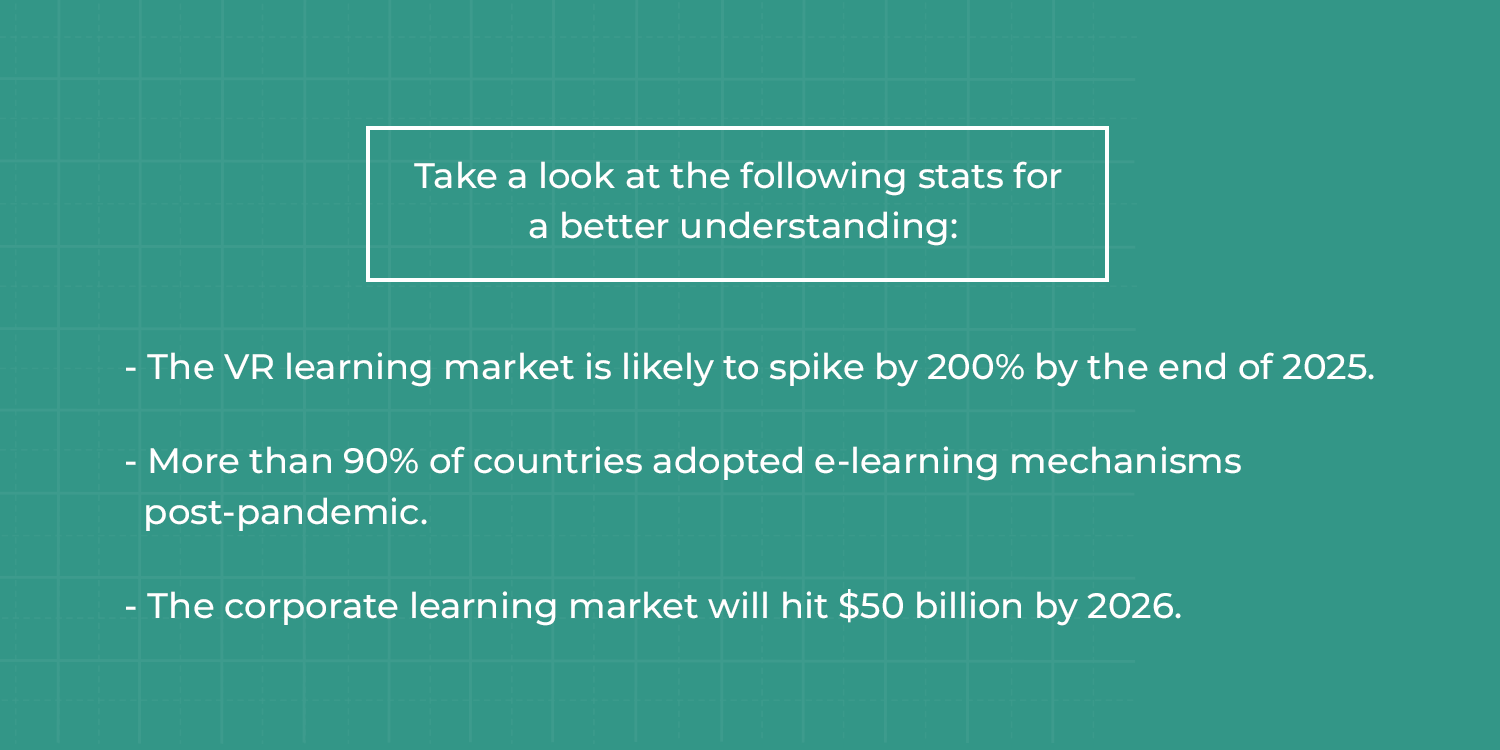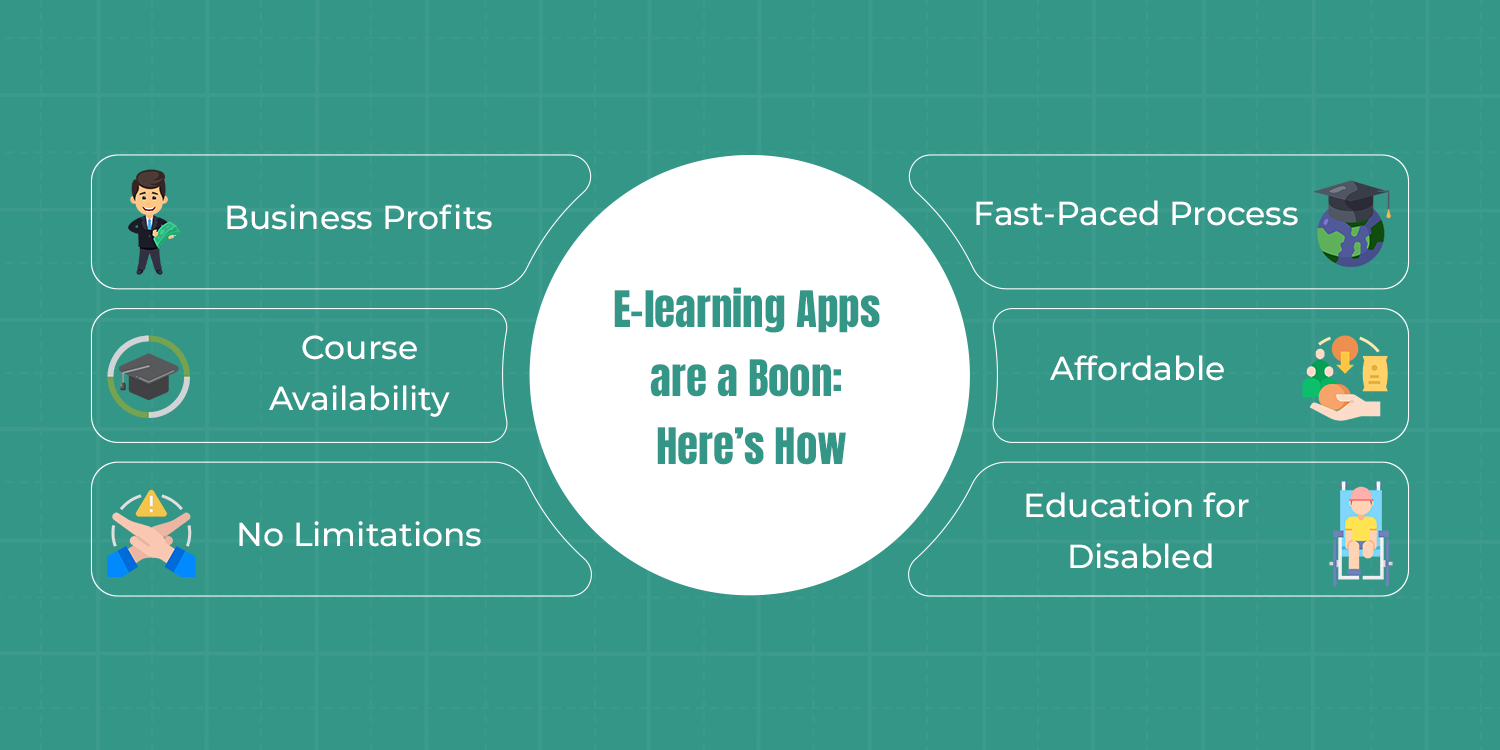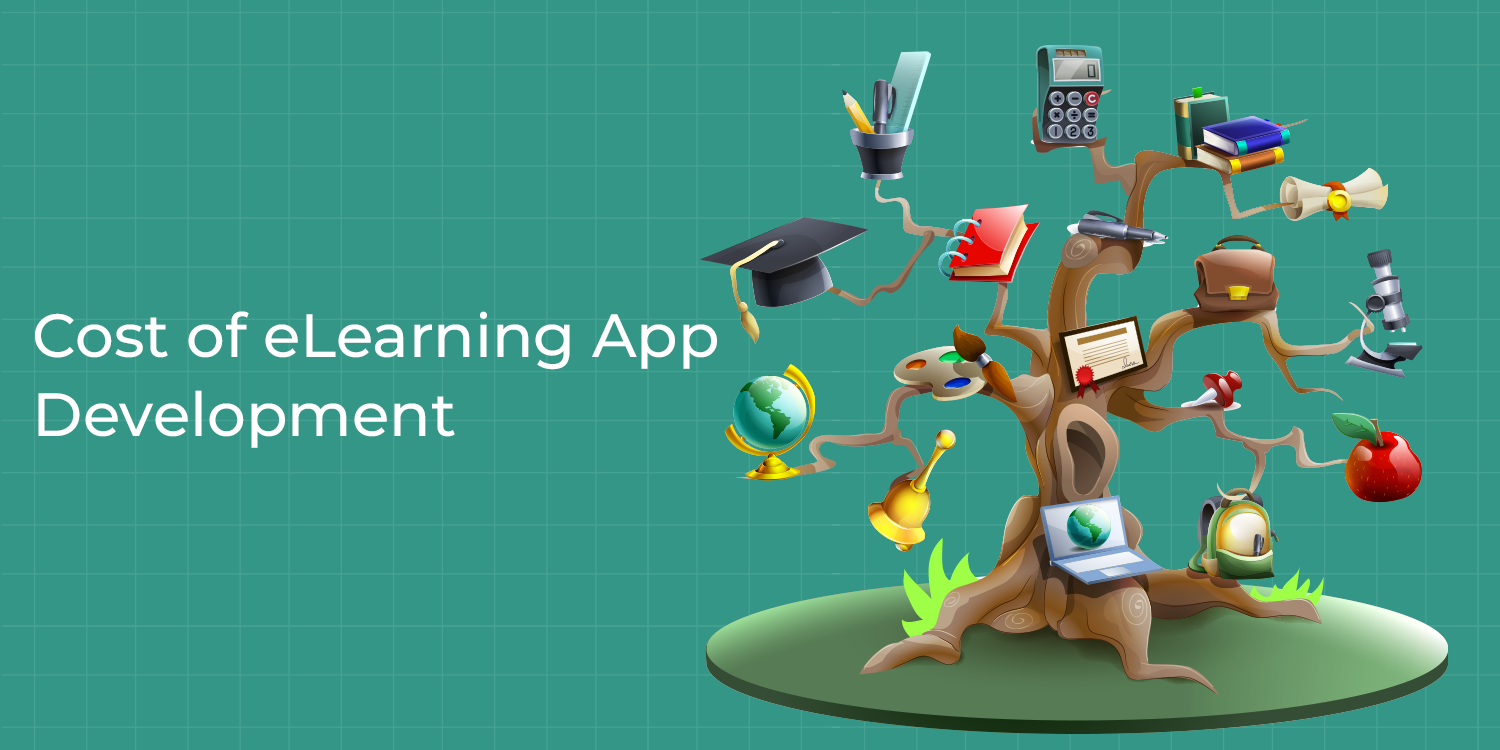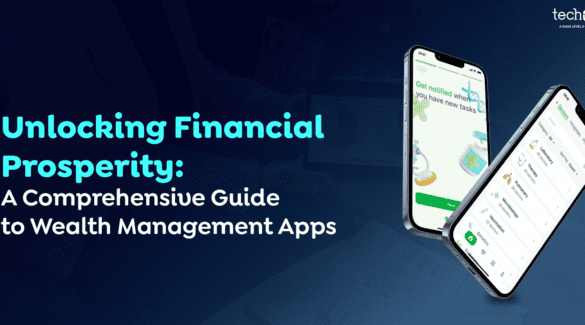17 May 2022
Updated on January 3rd, 2023
How much does it cost to develop an e-learning app?
Ankit Singh

Today, the world is highly competitive, and it has become necessary to keep up with the rising competitiveness to acquire the edge you deserve. Therefore, it is vital to be updated with advanced skills and modern technology that can help you obtain your desired objectives.
To acquire knowledge and understand the same, people are turning to e-learning platforms that enable them to virtually learn efficiently about anything and everything.
Therefore, e-learning apps have received immense popularity amongst people of all age groups since it is a fun-learning method that intrigues their audience to stick to the app.
Don’t you think it might be one of the reasons for entrepreneurs to emphasize e-learning app development?
If you’re hooked with the education industry, now is your chance to build one for your target audience. Fortunately, this article will talk about everything you need to know about the same, especially the cost to develop a mobile app.
So, let’s get started?
More About eLearning App Development
The pandemic posed a huge challenge in front of the educational institutions built for learners to attend the school for learning. However, the challenge was soon transformed into opportunity when schools began designing new learning patterns, one of which is e-learning that efficiently connects teachers with students digitally to bridge the gap.
The icing on the cake is since the classes can be taken from the comfort of one’s place, learning can easily reach millions of people worldwide.
But why are people adopting e-Learning app development?

Impressive, isn’t it?
Types of E-Learning
Mainly there are three kinds of e-learning apps that can be built depending on the purpose and the target audience of the business. Take a look at the following to figure out the business model that will work best for you:
1. Personal Learning
The personal learning apps are the most convenient ones as the students straightaway register with an account and begin taking courses. Moreover, the online courses are pre-developed and uploaded on the platform; thus, students can learn at their own pace and conditions.
2. Corporate Training
Learning apps are not only adopted by institutions and their students, but it has become a buzzword in the corporate world as well. These apps are now leveraged in corporate training to train the employees internally. Some of the most popular examples are Moddle and Yammer.
3. Educator’s App
Undoubtedly, virtual learning applications are ideal for teachers to teach their students digitally. The interface is simpler than ever, and teachers can easily share their notes, study material, lesson plans, etc.
E-learning Apps are a Boon: Here’s How

1. Business Profits
Corporate training is highly adopted by businesses, especially in countries like the USA and Europe. Therefore, the amalgamation of these platforms is likely to enhance employees’ skills and quality performance at its best, and there’s no looking back.
2. Course Availability
Unlike having to wait for school and college intakes, students can register anytime for the online courses. Additionally, these courses can be conveniently taken at any time with the help of a smartphone and a stable internet connection.
3. No Limitations
The best part about using an e-Learning platform is that it does not support any age barrier. Kids and even adults register on the same and continue their education whenever however they like.
4. Fast-Paced Process
Traditional learning is long gone, and not to overlook mentioning, it was a slow process. Students had to commute to the school; moreover, textbook learning isn’t as fun as online learning integrated with videos, images, activities, and whatnot!
The e-learning mechanism is brimming with success and is intriguing students to take part in projects and activities that otherwise would not have added much value to their learning.
5. Affordable
There are students or learners who can not afford expensive tuition fees. In other cases, many regions do not have the availability of schools for students’ education. Thus, e-learning apps are a perfect affordable alternative for people going through the same.
6. Education for Disabled
The Internet is a real blessing for people with disabilities as it has made their lives easier by providing trouble-free access to education and food delivery, e-banking, healthcare, and much more.
Are you now convinced to develop an e-learning app?
Connecting with the best e-learning app development company is an incredible shot if we are on the same page!
What do you think?
Factors to Consider While Building an E-Learning App
 1. Retain Confidence in Your App Idea
1. Retain Confidence in Your App Idea
Don’t forget that industries are investing their sweat, blood, and money in creating their space in the digital world. Therefore, you must not step into the ecosystem without prior research on what your competitors are pursuing.
Additionally, you need to think of strategies that’ll differentiate your presence from the rest of your competitors. The key is to keep faith in your app idea and execute them with the help of your best resources.
2. Examine Your Target Audience
Are you aware of the audience you’re going to serve? For example, are you catering to kids or adults?
It is vital to acquire answers to these questions to build an app that’ll solve the purpose of your target audience.
3. Emphasize Elegant User Interface
Pleasing aesthetics is a gamechanger in the mobile app ecosystem, and it is precisely what you must serve to your app users. A user should be able to navigate through the app seamlessly, which is why you must hand over the project to the UI experts.
4. Build an MVP
Minimum Viable Product is a concept of developing a product with the basic features to roll out for the early testers. Users provide their feedback on the app, and thus, developers further make amendments based on the same.
5. Lay a Perfect Monetization Model
Apart from what you have in mind that you want to bring to the real world, making profits is another important reason behind the creation of an exceptional app. Therefore, figure out the best monetization model as per your business plan and work on the same.
What Segregrates a Flawless eLearning App from Others?
To develop a terrific elearning app, the first step is to design an app that efficiently caters to your customer’s needs. Therefore, it is essential to leverage features for students, teachers, and guardians that would intrigue them to opt to download your app than your competitors.
What kind of features, you ask?
Take a look!
The community of e-learning app users is likely to be students; therefore, you need to ensure that the application is engaging enough.
Here are some of the top-notch features to obtain the desired results:
1. Delivery Mechanism
Content delivery of an education app is an integral element. These apps have a database incorporated that holds the entire data to be delivered. Thus, all the lessons, courses, etc., provided on a virtual education app are only because its database is structured properly.
2. Tests, Activities, Etc!
An e-learning app must also emphasize activities, tests, and more along with the delivery of courses. For example, teachers can interact with the students, take their queries, etc., before presenting them with the tests to gain insights into their course knowledge.
3. Gamification
For starters, gamification is the integration of games into e-learning apps to foster engagement, and some of the popular elements include:
– Reward Loops: These are the rewards, virtual currency, etc., offered to students on their good performance.
– Badges and Points: These are the indicators or progress marked within the app.
4. Personalized Teaching
Personalization in apps is the idea of tweaking the app experience for learners for comfort and an enhanced learning ecosystem. Thus, personalized learning is not only about delivering videos, study material, etc. It is about delivering solutions in context to students’ requirements and thinking.
5. In-App Messages
The in-app messaging feature makes it simpler for teachers and students to interact via messages and helps enhance learners’ retention.
While students can type and send their queries, teachers can answer the same, send rewards and reminders, etc, with the help of the feature.
6. Push-Notifications
Push notifications encourage students to visit the app more often and engage with the same. These notifications are triggered by the developer on the user’s smartphone. For instance, a push notification can ask for users’ feedback on the last lesson.
7. Payment Gateways
You may adopt any monetization model for your app, considering the strategy and requirements. For instance, in-app purchases would want customers to pay for the additional features; therefore, you must leverage an in-app payments system for direct settlement by the user.
8. Offline Learning
Most elearning apps enable downloading study material for offline use. Therefore, users can consume the downloaded content without an internet connection.
Convenient, right?
To start with, the interface built for the teacher’s panel should be simple yet elegant. Furthermore, the features listed below will do a perfect job:
1. Registration
To start using the application, it is vital for users to register with an account. Once they enter their information and hit the ‘Register’ button, a confirmation email will be forwarded. After completing the steps, app users will be able to set a password to access their account and monitor their dashboard.
2. Schedule Classes
The app must enable teachers to schedule classes and upload recordings of the same for those who were not able to attend.
3. Reviews and Feedback
After teachers deliver their lessons, feedback can be initiated to learn more about the improvements students want to seek in the lessons. Therefore, teachers can work on the same to enhance the experience.
4. Student Queries
One of the most crucial features to add in an e-learning app for teachers is to provide them the ability to take student queries. Sure, attending a course is great, but what’s the advantage if students are not able to ask questions and clear their doubts?
5. Assignments and Deadlines for Students
As mentioned earlier, posting assignments for students to check on their clarity of the concept is vital. Therefore, integrate a feature that enables teachers to do the same and also nudge with deadlines.

Guardians and parents must check on their children’s curricular performance; thus, there must be features for them to easily access the information on kids’ behavior, habits, grades, and more. Here are a few must-have features:
1. Registration
This feature requires guardians to register their child and add other caretakers’ profiles if any.
2. Student Progress
The cherry on top is the student progress feature that not only enables guardians to track their kid’s performance but what they are doing in real-time.
3. Course Progress
The feature will enable students to keep a check on their course clarity. Additionally, the feature also keeps track of their attendance, exam schedule, etc.
4. Connect with Teachers
Do you remember tagging along with your parents on PTM days? While it’s no longer the system, e-learning apps can enable guardians to connect with teachers for queries, reports, and overall effective communication.
5. Student Leaderboard
The leaderboard is a scoreboard where students are ranked, and their progress can be tracked by the guardian. In addition, many apps allow sending encouraging messages to the students for their motivation.
Here comes one of the most awaited sections of the blog- e-learning mobile app development cost.
Now that you have come this far, the idea must be to develop an efficient e-learning app for your target audience.
Start by thinking about what element would let your customers stick to the app! Once the solution is constructed, emphasize the cost of app development. Therefore, take a look at the following factors that influence the entire cost:
1. Choice of the Platform
Have you decided on the platform you’ll build your app for? Notably, it is one of the primary steps before starting the app development process since you’ll have to make a choice between Android, iOS, both, or other.
App developers can choose between two approaches: Native or Hybrid. While native apps are specifically built for different platforms, hybrid apps use a single codebase to develop apps for multiple platforms. Thus, the hybrid approach costs lessor than the native approach.
2. Features and Complexity of the Platform
Undoubtedly, e-learning apps comprise video and audio content, interactive exercises, etc., which lead to higher app development costs. Additionally, developers choose to integrate technologies like Chatbot that can take student queries automatically.
The idea is simple: the more the features and technologies, the higher will be the development cost.
3. App Type
Globally, app owners invest about $22.6 billion in app development. Notably, factors like business type, potential customers, and services enable framing the app budget.
In the case of a customer service model, app development also demands external APIs that contribute to additional costs.
4. App Design & Functionality
Each app varies due to its design and functionality. Most app developers emphasize integrating advanced app features for smooth functioning of the same and enhanced user experience.
5. App Security
No wonder apps hold truckloads of data for functioning seamlessly. Therefore, the data might be confidential, employee data, etc., that has to be kept safe from vulnerabilities. To achieve the same, a robust hosting provider and cutting edge security measures have to be adopted that’ll add to the app development cost.
Furthermore, the adoption of security measures also depends on the business size!
6. App Updation and Maintenance
Mobile apps demand maintenance in the form of app updates that need to be rolled out from time to time. Thus, developers must deliver efficient technical assistance to revamp the app integrations, which leads to increased expense.
7. App Development Team
The purpose of app development is resolved only when it has an exceptional developer or team behind the same. Teaming up with an e-learning app development company bags the support of the best domain experts and other creative resources. Thus, they deliver excellent product development services!
How Much Does Techugo Cost for E-Learning App Development?
(a) For MVP
A dedicated team of analysts, developers, project managers, and designers is allocated to develop an MVP, which takes around 3-5 months for the entire process.
Cost: 30k-80k USD
(b) For CAW
The Concept Analysis Workshop emphasizes analysis & design, including the wireframing, prototype, etc. Building CAW can take up to 5 to 7 weeks, and costs about 10-20% of the entire project cost.
Cost: 7k-20k USD
(c) For the Complete Product
Undoubtedly, the development of the entire product takes up more time than building an
MVP and CAW, due to time-taking processes like the amalgamation of features, optimization, etc.
Cost: 40k-500k USD
To Sum Up!
The e-learning app market is booming, and with its rise being at its apex, if you want to set your foot in the domain as a digital education provider, now is your best shot!
Have a flawless app idea in mind and are looking forward to collaborating with the best technology partner?
Then, reach out to us at Techugo- the top mobile app development company in India, to turn your vision into reality.
All the best!
Get in touch.
Write Us
sales@techugo.comOr fill this form






